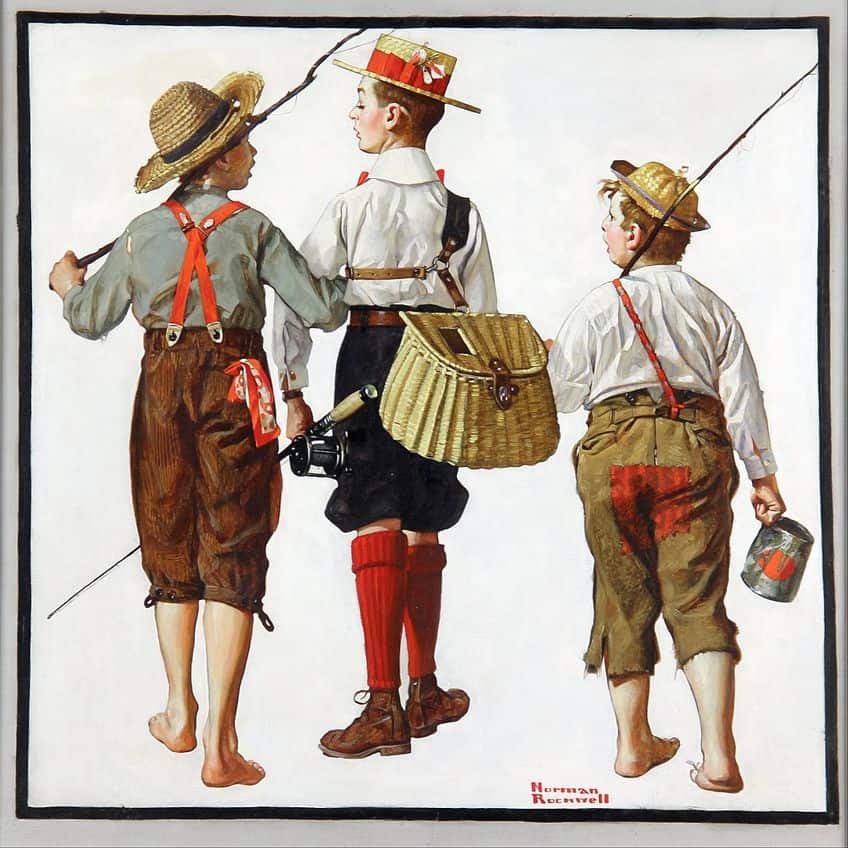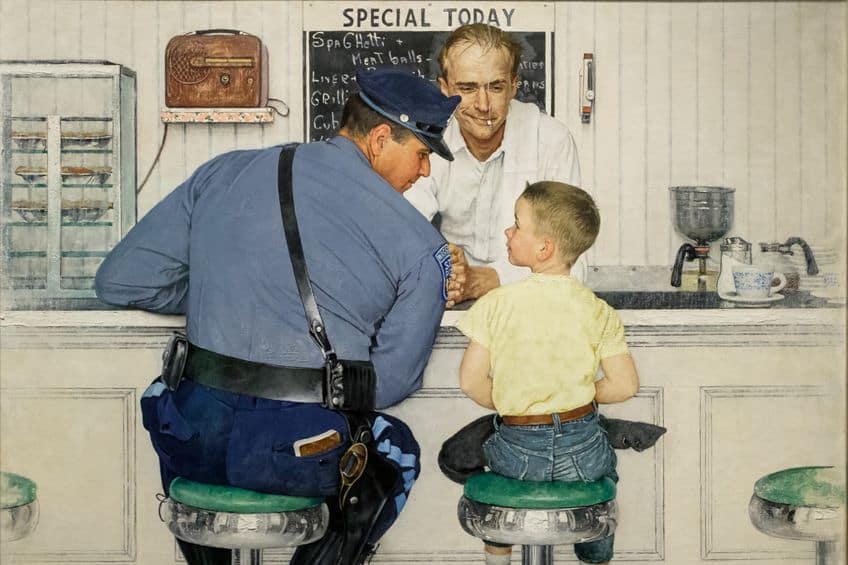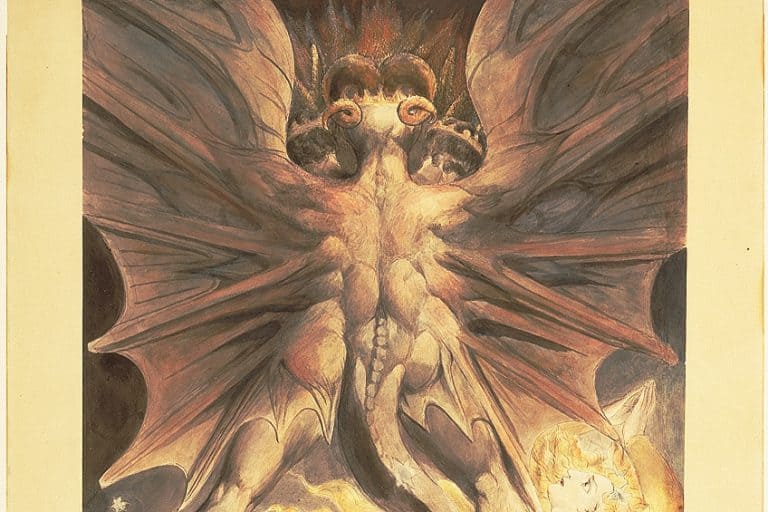“The Runaway” by Norman Rockwell – A Famous Artwork Analysis
The Runaway, created by Norman Rockwell in 1958, stands as one of the artist’s most iconic works, encapsulating the warmth, humor, and narrative depth that characterized his oeuvre. The painting depicts a young boy, with a small bundle on a stick, seated at a diner counter next to a kindly police officer. The scene, rendered in Rockwell’s meticulous and expressive style, exudes a sense of Americana, capturing a moment of gentle guidance and understanding between the law and the youthful spirit. The Runaway not only showcases Rockwell’s technical prowess and storytelling ability but also reflects his deep appreciation for the subtleties of human interaction and the everyday experiences of mid-20th-century America.
Table of Contents
- 1 Key Takeaways
- 2 Background and Inspiration
- 3 Artwork Analysis
- 4 The Runaway’s Journey
- 5 The Scene Behind The Canvas
- 6 Frequently Asked Questions
- 6.1 What Is the Significance of the Interaction Between the Police Officer and the Boy in The Runaway?
- 6.2 What Is the Historical Context Surrounding The Runaway and Its Creation?
- 6.3 How Has The Runaway Been Interpreted in American Art History and Culture?
- 6.4 What Details in The Runaway Contribute to Its Storytelling and How Do They Reflect Rockwell’s Style?
Key Takeaways
- The Runaway is a celebrated 1958 oil on canvas painting by Norman Rockwell, which depicts an evocative narrative scene.
- Norman Rockwell’s work is known for its storytelling capability, capturing snapshots of American life with depth and warmth.
- The painting has been shared widely, featuring on The Saturday Evening Post cover, and continues to resonate as a classic example of Rockwell’s artistry.
Background and Inspiration
| Artist | Norman Rockwell (1894 – 1978) |
| Date Created | 1958 |
| Medium | Oil on canvas |
| Genre | Genre painting |
| Period/Movement | American Realism and Regionalism |
| Dimensions (cm) | 90 x 89 |
| Series/Versions | Part of Rockwell’s cover illustrations for The Saturday Evening Post |
| Where Is It Housed? | Norman Rockwell Museum, Stockbridge, Massachusetts, United States |
| What It Is Worth | Estimated at several million dollars, though the exact value can vary based on market conditions and provenance. |
The Runaway is a classic piece of American art that captures a poignant moment in a narrative style for which Norman Rockwell is renowned. Created in 1958, this oil on canvas painting has garnered widespread acclaim for its evocative portrayal of American life. It depicts a young boy seated at a diner counter, right next to a police officer, eliciting a sense of storytelling that invites viewers to ponder the circumstances leading up to the scene.

Rockwell’s talent for reflecting societal values and cultural moments is evident in The Runaway, which was featured on the cover of The Saturday Evening Post in September 1958. The artwork reflects Rockwell’s keen observation of human interactions within the framework of daily life, further solidifying his status as a chronicler of the American experience. Through this work, viewers are offered a glimpse into the artist’s interpretation of themes such as youth, authority, and community.
1950s America and Cultural Context
In the 1950s, America was experiencing a period of economic prosperity and cultural conformity. Norman Rockwell, an artist already known for his keen interpretations of American life, captured moments that spoke to the collective consciousness of the nation. His paintings were a lens through which the idyllic and optimistic post-war American lifestyle was both reflected and subtly critiqued. Rockwell’s The Runaway emerged against this backdrop as a portrayal of an American scene imbued with Regionalism—a movement that emphasized rural and small-town Americana.
Rockwell’s knack for storytelling through art is particularly evident in this piece, which was featured on the cover of The Saturday Evening Post, a publication famed for its role in shaping American identity. The Runaway resonates with the innocence and adventure present in the concept of American freedom and individualism during that epoch.
The artwork, by virtue of its placement in The Saturday Evening Post, reached a broad audience, contributing to Rockwell’s status as one of the most beloved American artists of the time. His ability to articulate the mood and values of 1950s America made The Runaway an enduring piece of cultural commentary. The painting not only epitomizes the ethos of Regionalism but also serves as a historical document of the era’s societal norms and ideals.
Artwork Analysis
The Runaway is a classic example of American genre painting that encapsulates Norman Rockwell’s narrative style, utilizing oil on canvas to portray a touching scene with strong thematic elements.

Subject Matter and Characters
This oil on canvas depicts a young boy, assumed to be a runaway, sitting at a diner counter next to a policeman. The scene is set in an American diner, suggested by the presence of a soda fountain and bar stools.
Rockwell’s inclusion of these characters in such a setting plays on the notion of the innocence and naiveté of youth, contrasted with the protective and guiding figure of authority.

Artistic Style and Technique
Rockwell’s painting style aligns with Regionalism, a 20th-century American art movement that emphasized rural and small-town themes. In The Runaway, his use of color, detail, and composition brings the two main characters to life with a sense of warmth and narrative depth.
The technique of oil on canvas allows Rockwell to achieve rich textures and a high degree of realism, which is a hallmark of his work.

Symbolism and Themes
Thematically, The Runaway intertwines symbols of Americana with the themes of safety, guardianship, and community. The boy and the policeman are central to the painting’s narrative, symbolizing the intersection of wanderlust and social order.
The interaction between characters evokes a sense of care and protective custody, a key message Rockwell often incorporated into his art to reflect his idealistic views on American society.

The Runaway’s Journey
The Runaway captures an enduring moment symbolizing innocence and protection, reflecting Norman Rockwell’s quintessential Americana style. The Runaway, an oil on canvas painting by Norman Rockwell, premiered as a cover illustration for The Saturday Evening Post on September 20, 1958. It portrays a young boy and a Massachusetts State Trooper seated at a diner counter, the boy’s hands resting on his lap and the trooper’s shoulder shown in a comforting gesture. The scene is set in a Howard Johnson’s restaurant, adding a layer of familiar Americana to the narrative. Upon publication, the reception of the piece was overwhelmingly positive, as it resonated with the public for its depiction of compassion and civic duty.

Legacy and Influence
This iconic image has found a permanent home at the Norman Rockwell Museum in Massachusetts, as part of its expansive collection. The museum preserves and interprets Rockwell’s work and the best of American illustration. The Runaway holds a notable place in the Freedom series, communicating a message that transcended the boundaries of its time. Its sentimental portrayal of the trust between a child and a police officer has made it a symbolic representation of law enforcement’s mission to protect and serve. The work’s copyright is retained by the Rock illustration, cementing its status as a cultural icon.
Over the years, The Runaway has continued to influence and embody the spirit of American freedom and the compassionate role of law enforcers in society.
The Scene Behind The Canvas
In crafting The Runaway, Norman Rockwell utilized real-world models and locations to bring authenticity to his work. An emphasis on photographic reference was a staple in his methodology, anchoring his paintings in relatable American experiences.

Models and Locations
Norman Rockwell, renowned for his detailed genre paintings, often included local community members in his work. For The Runaway, he featured Ed Locke, a young boy, as the central runaway figure. Donning a red kerchief, Locke gave life to the painting with his innocent appearance. The adult figures were modeled by a real State Trooper, Richard Clemens, and a local diner counterman. Rockwell created this piece in his studio in the town of Stockbridge, Massachusetts, which was his home for many years.
The setting depicted is reminiscent of Howard Johnson’s Restaurant, a familiar sight in mid-20th-century America, and places like Pittsfield, a city near Stockbridge known for its diners.
Photography In Rockwell’s Work
Rockwell often used photography as a groundwork tool to capture the underlying realities of American life. His process included taking photographs of his models, which would serve as a visual reference throughout the painting process. This approach allowed for a precise and realistic rendering of scenes. It’s reflected in the meticulous details seen in The Runaway, from the interactions between the characters to the authentic portrayal of the uniforms and diner interior. Rockwell’s use of photography is documented in the book, Norman Rockwell: Behind the Camera, which explores how these photographs informed his iconic illustrations.

Norman Rockwell’s The Runaway is a masterful blend of narrative and artistry that continues to resonate with audiences today. Through its depiction of a simple yet profound moment of compassion and guidance, Rockwell captures the essence of American values and the universal themes of trust and protection. The painting’s enduring popularity is a testament to Rockwell’s ability to tell stories that touch the heart, reflecting his unique talent for portraying the depth and complexity of human relationships within the framework of everyday life. The Runaway remains a quintessential piece of American art, symbolizing the timeless connection between individuals and the community.
Frequently Asked Questions
What Is the Significance of the Interaction Between the Police Officer and the Boy in The Runaway?
In The Runaway, the interaction between the police officer and the boy represents a compassionate and protective aspect of law enforcement. Rockwell’s depiction underscores a gentler, more nurturing side of police work, in contrast to its more authoritative role.
What Is the Historical Context Surrounding The Runaway and Its Creation?
The Runaway was created in 1958 during a post-war era in which America was experiencing a sense of nostalgia and idealism. The painting reflects the mid-20th-century American values, where the imagery of small-town life and community support were prominent in the collective consciousness.
How Has The Runaway Been Interpreted in American Art History and Culture?
In American art history and culture, The Runaway is often seen as an emblem of innocence and the simplicity of small-town life. It has become an iconic representation of the mid-century American zeitgeist, highlighting the nation’s yearning for stability and harmony during a time of rapid change.
What Details in The Runaway Contribute to Its Storytelling and How Do They Reflect Rockwell’s Style?
The details in The Runaway, such as the boy’s facial expression, the careful placement of the police officer, and the diner setting, contribute to a narrative that is both intimate and relatable. These elements showcase Rockwell’s ability to capture the essence of American life through vivid storytelling and meticulous attention to detail.
Isabella studied at the University of Cape Town in South Africa and graduated with a Bachelor of Arts majoring in English Literature & Language and Psychology. Throughout her undergraduate years, she took Art History as an additional subject and absolutely loved it. Building on from her art history knowledge that began in high school, art has always been a particular area of fascination for her. From learning about artworks previously unknown to her, or sharpening her existing understanding of specific works, the ability to continue learning within this interesting sphere excites her greatly.
Her focal points of interest in art history encompass profiling specific artists and art movements, as it is these areas where she is able to really dig deep into the rich narrative of the art world. Additionally, she particularly enjoys exploring the different artistic styles of the 20th century, as well as the important impact that female artists have had on the development of art history.
Learn more about Isabella Meyer and the Art in Context Team.
Cite this Article
Isabella, Meyer, ““The Runaway” by Norman Rockwell – A Famous Artwork Analysis.” Art in Context. June 10, 2024. URL: https://artincontext.org/the-runaway-by-norman-rockwell/
Meyer, I. (2024, 10 June). “The Runaway” by Norman Rockwell – A Famous Artwork Analysis. Art in Context. https://artincontext.org/the-runaway-by-norman-rockwell/
Meyer, Isabella. ““The Runaway” by Norman Rockwell – A Famous Artwork Analysis.” Art in Context, June 10, 2024. https://artincontext.org/the-runaway-by-norman-rockwell/.











